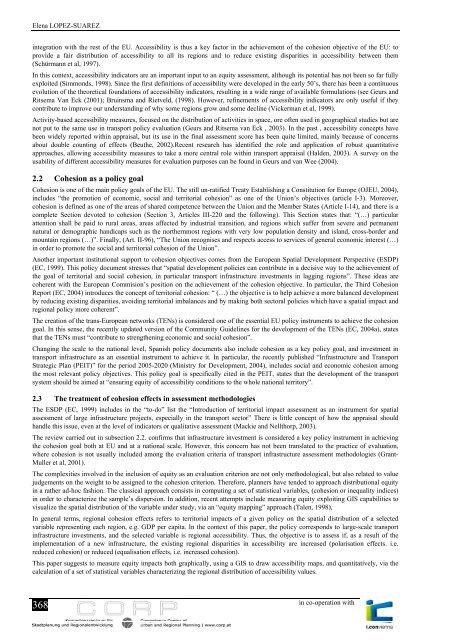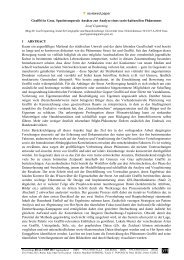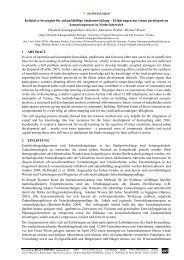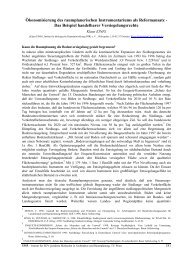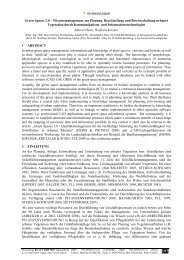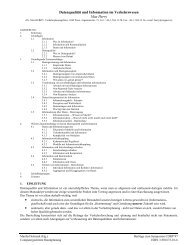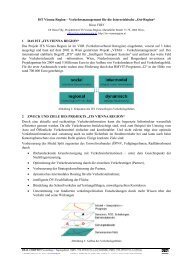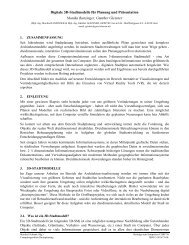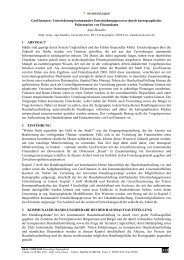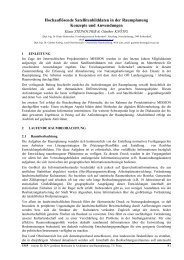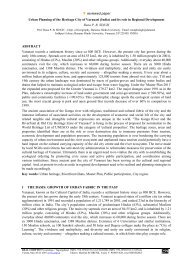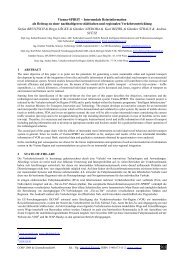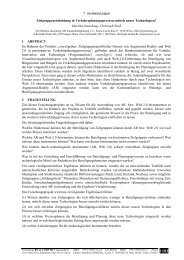C O R P 2 0 0 6
C O R P 2 0 0 6
C O R P 2 0 0 6
Erfolgreiche ePaper selbst erstellen
Machen Sie aus Ihren PDF Publikationen ein blätterbares Flipbook mit unserer einzigartigen Google optimierten e-Paper Software.
Elena LOPEZ-SUAREZ<br />
integration with the rest of the EU. Accessibility is thus a key factor in the achievement of the cohesion objective of the EU: to<br />
provide a fair distribution of accessibility to all its regions and to reduce existing disparities in accessibility between them<br />
(Schürmann et al, 1997).<br />
In this context, accessibility indicators are an important input to an equity assessment, although its potential has not been so far fully<br />
exploited (Simmonds, 1998). Since the first definitions of accessibility were developed in the early 50’s, there has been a continuous<br />
evolution of the theoretical foundations of accessibility indicators, resulting in a wide range of available formulations (see Geurs and<br />
Ritsema Van Eck (2001); Bruinsma and Rietveld, (1998). However, refinements of accessibility indicators are only useful if they<br />
contribute to improve our understanding of why some regions grow and some decline (Vickerman et al, 1999).<br />
Activity-based accessibility measures, focused on the distribution of activities in space, ore often used in geographical studies but are<br />
not put to the same use in transport policy evaluation (Geurs and Ritsema van Eck , 2003). In the past , accessibility concepts have<br />
been widely reported within appraisal, but its use in the final assessment score has been quite limited, mainly because of concerns<br />
about double counting of effects (Beuthe, 2002).Recent research has identified the role and application of robust quantitative<br />
approaches, allowing accessibility measures to take a more central role within transport appraisal (Halden, 2003). A survey on the<br />
usability of different accessibility measures for evaluation purposes can be found in Geurs and van Wee (2004).<br />
2.2 Cohesion as a policy goal<br />
Cohesion is one of the main policy goals of the EU. The still un-ratified Treaty Establishing a Constitution for Europe (OJEU, 2004),<br />
includes “the promotion of economic, social and territorial cohesion” as one of the Union’s objectives (article I-3). Moreover,<br />
cohesion is defined as one of the areas of shared competence between the Union and the Member States (Article I-14), and there is a<br />
complete Section devoted to cohesion (Section 3, Articles III-220 and the following). This Section states that: “(…) particular<br />
attention shall be paid to rural areas, areas affected by industrial transition, and regions which suffer from severe and permanent<br />
natural or demographic handicaps such as the northernmost regions with very low population density and island, cross-border and<br />
mountain regions (…)”. Finally, (Art. II-96), “The Union recognises and respects access to services of general economic interest (…)<br />
in order to promote the social and territorial cohesion of the Union”.<br />
Another important institutional support to cohesion objectives comes from the European Spatial Development Perspective (ESDP)<br />
(EC, 1999). This policy document stresses that “spatial development policies can contribute in a decisive way to the achievement of<br />
the goal of territorial and social cohesion, in particular transport infrastructure investments in lagging regions”. These ideas are<br />
coherent with the European Commision’s position on the achievement of the cohesion objective. In particular, the Third Cohesion<br />
Report (EC, 2004) introduces the concept of territorial cohesion: “ (…) the objective is to help achieve a more balanced development<br />
by reducing existing disparities, avoiding territorial imbalances and by making both sectoral policies which have a spatial impact and<br />
regional policy more coherent”.<br />
The creation of the trans-European networks (TENs) is considered one of the essential EU policy instruments to achieve the cohesion<br />
goal. In this sense, the recently updated version of the Community Guidelines for the development of the TENs (EC, 2004a), states<br />
that the TENs must “contribute to strengthening economic and social cohesion”.<br />
Changing the scale to the national level, Spanish policy documents also include cohesion as a key policy goal, and investment in<br />
transport infrastructure as an essential instrument to achieve it. In particular, the recently published “Infrastructure and Transport<br />
Strategic Plan (PEIT)” for the period 2005-2020 (Ministry for Development, 2004), includes social and economic cohesion among<br />
the most relevant policy objectives. This policy goal is specifically cited in the PEIT, states that the development of the transport<br />
system should be aimed at “ensuring equity of accessibility conditions to the whole national territory”.<br />
2.3 The treatment of cohesion effects in assessment methodologies<br />
The ESDP (EC, 1999) includes in the “to-do” list the “Introduction of territorial impact assessment as an instrument for spatial<br />
assessment of large infrastructure projects, especially in the transport sector” There is little concept of how the appraisal should<br />
handle this issue, even at the level of indicators or qualitative assessment (Mackie and Nellthorp, 2003).<br />
The review carried out in subsection 2.2. confirms that infrastructure investment is considered a key policy instrument in achieving<br />
the cohesion goal both at EU and at a national scale. However, this concern has not been translated to the practice of evaluation,<br />
where cohesion is not usually included among the evaluation criteria of transport infrastructure assessment methodologies (Grant-<br />
Muller et al, 2001).<br />
The complexities involved in the inclusion of equity as an evaluation criterion are not only methodological, but also related to value<br />
judgements on the weight to be assigned to the cohesion criterion. Therefore, planners have tended to approach distributional equity<br />
in a rather ad-hoc fashion. The classical approach consists in computing a set of statistical variables, (cohesion or inequality indices)<br />
in order to characterize the sample’s dispersion. In addition, recent attempts include measuring equity exploiting GIS capabilities to<br />
visualize the spatial distribution of the variable under study, via an “equity mapping” approach (Talen, 1998),<br />
In general terms, regional cohesion effects refers to territorial impacts of a given policy on the spatial distribution of a selected<br />
variable representing each region, e.g. GDP per capita. In the context of this paper, the policy corresponds to large-scale transport<br />
infrastructure investments, and the selected variable is regional accessibility. Thus, the objective is to assess if, as a result of the<br />
implementation of a new infrastructure, the existing regional disparities in accessibility are increased (polarisation effects. i.e.<br />
reduced cohesion) or reduced (equalisation effects, i.e. increased cohesion).<br />
This paper suggests to measure equity impacts both graphically, using a GIS to draw accessibility maps, and quantitatively, via the<br />
calculation of a set of statistical variables characterizing the regional distribution of accessibility values.<br />
368<br />
in co-operation with


